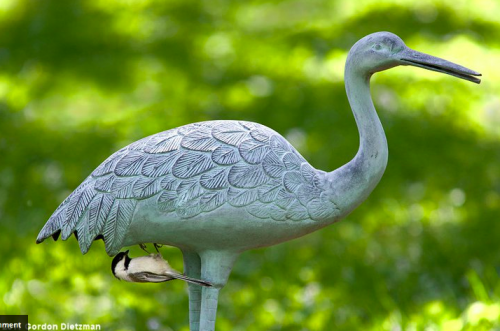 My coworker and fellow Park Ranger Gordon Dietzman posted this photo of a black-capped chickadee nesting in a crane statue in his yard. Oh dear...
My coworker and fellow Park Ranger Gordon Dietzman posted this photo of a black-capped chickadee nesting in a crane statue in his yard. Oh dear...
Baby Owls Branching Out
I'm in the midst of my busies month. If I'm not at the National Park Service engaged in ranger work, I'm on the road at a bird festival, birding the crap out of whatever state I'm in. It's a horrific schedule but it's loads of fun. And at the end of the month of May, I get a weekend off to celebrate my wedding anniversary with Non Birding Bill (we'll be on year lucky 13--boy, why did I think it would be a good idea to get married in May?). A friend of mine who is new to birding asked if I'd like to go out next week. My first answer was that I was too busy. But then I saw on Tuesday that it was supposed to be 80 degrees and I just couldn't say no. So we did some birding near my apartment. It's warbler season and they are dripping off the trees. The few days I was home, I had a golden-winged warbler outside my bedroom window ever morning!
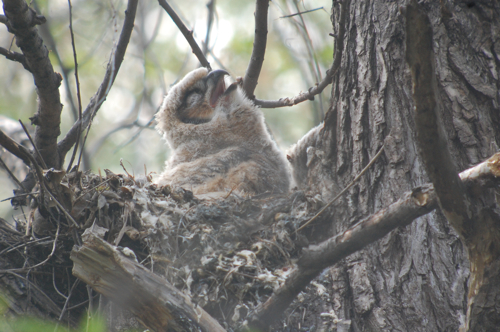
I showed him the owl nest and boy the two young owls were panting like crazy. Birds don't sweat like humans and pant like dogs when their hot. The young owls still have some of their thick down that protects them in snow storms when they hatch earlier. Doesn't it look like it's saying, "Oh man, I'm so hot, ugh."

I didn't see either adult and figured that since the young were so large, they were tucked in a nearby conifer for shade from the warm sun. As I looked at the nest from this angle, I realized how trashed it is. Check out these photos from an earlier entry when the female was still incubating. Note how the nest material was all the way to to the stick. In the above photo, it's well below that now. I thought to myself that these owls have to be in the brancher phase. That's when they are still downy but their feet are very strong and they begin to venture out of the nest. The young birds can even be blown out of the tree, yet their feet are strong enough to enable them to climb back up.
It looks like they have some feather development on their wings and back. I got confirmation on this a few days later from another nearby resident who has been watching the nest and he confirmed that babies had crawled out and were on branches 10 feet from the nest. Our little guys grow up so fast.
Cooper's Hawk Attacks Owl Nest
Well, Friday morning turned out to be far more exciting than I anticipated! I had to work at the park service in the afternoon and evening and I was meeting a friend for a late breakfast. I thought that since it was warm, I'd peek at the great horned owl nest in my neighborhood and see if the owlets were more visible...

One owlet was easily visible with the naked eye on approach. Great horned owls do not build their own nests, they take over old squirrel, hawk or heron nests. They don't even make any renovations before they use it, they just squat. As the chicks grow, the nests soon shrink. Between the dwindling nest and the larger chicks, the female no longer fits very well and perches near the chicks.

It appears that the nest contains two owlets! When I arrived to the general nesting area, I could hear the crows heartily mobbing. I saw the male fly over with a flock of about 20 crows in tow. The chicks showed a bit of interest in the commotion but mostly laid low.

The female was very interested in the crow activity as she watched the crows surround the other owl. What was interesting was that I thought the crows were chasing one owl, I later ran into a fellow birder who was close the crows and he said the crows were after two great horned owls and a third flew in. I wonder now that as I was watching her keen interest in the crow activity, if she was responding to an intruding great horned owl into her territory rather than the corvids gathering around her mate?

She soon left the nest to try to get a better look at the mobbing crows but still would turn around to keep an eye on her chicks. It was so strange to me to see a secretive owl perched out in the open in the middle of the morning. Not long after I took this photo, she bolted off into the middle of the flock of crows. The owls all went in separate directions and the crows split their murder into 2 smaller groups, diving and cawing at the owls.

With the female away, the young owlets closed their eyes and assumed an upright position. I wondered if this was all part of a camoflauge instinct? With the adults going after the crows, it stirred up the surrounding birds. Robins began giving their alarm calls and then an adult Cooper's hawk flew in. The hawk missed its intended prey...then suddenly noticed one of the owls and started diving at it and screaming its call. If you're not familiar with a Cooper's hawk mobbing an owl, let me remind you of the video of the Cooper's hawk mobbing a plastic owl (they never work to scare birds away).

The Cooper's hawk then made a wider pass and went straight for the owl nest, hell bent on mobbing the chicks. First it bounced off the nest and then started to make a second dive, by that time, the female great horned owl was back on the nest and ready to kick some serious accipiter ass if it tried it again. I have never seen a great horned move so fast in my entire life. I've always referred to them as the Sunday drivers of the raptor world...I got schooled--they can move very fast when they need to. The above photo is on the Cooper's hawk's second attempt at a dive on the nest. The blur above the nest is the female owl defending her chicks.

The angry Cooper's hawk perched nearby and shrieked out angry, "kek kek kek kek kek keks" at the great horned owl. I suspect this bird has a nest nearby.

The great horned owl stood at her nest above her chicks and hooted back her retorts after every kek the Cooper's hawk gave her. The owl even barked a few times in warning at the hawk. It was the weirdest argument I'd ever heard. As the two continued, a few crows gathered nearby to continue their remarks on the two predators they detested. Then, out of nowhere, a broad-winged hawk screamed nearby. Three raptors all at once! An owl, a buteo and an accipiter.

The chicks nestled against the female as if to say, "Yeah, my mom is awesome."
I wondered, how long was this battle going to last? The suspense was killing me...then I got my answer. I heard a helicopter coming fast and approaching low.

This was not digiscoped, this helicopter was THAT low. It was Metropolitan Mosquito Control dropping their corn pellets full of Bti and Methoprene to kill of mosquito larvae. The helicopter skirted the tops of the trees, the owl, crows and hawk scattered. The adult female owl apparently thought, "Cooper's hawk, yeah, I can kill that," but when the helicopter appeared her attitude shifted to, "yikes, too big for me kids, you're on your own, see ya!"

After the raptors scattered, pellets rained down and bounced off my body. I could hear nearby woodpeckers give low warning noises to each other. Robins were on high alert.

A couple of nearby mallards seemed to dig the pellets and tried to eat them as soon as they hit the water--they were the only birds who seemed to be unaffected by the strange aerial machine. The city assures me that the pellets are harmless both to me and the wildlife that might consume it. I was tempted to start running around like Cary Grant in a Hitchcock movie, but it's not so much fun with a spotting scope in tow.

The helicopter made a few more passes and a few moments later, one of the owls flew back with a few pesky crows hot on its tail.

She perched right above my head and the crows still followed. She looked over to see her chicks were still in the nest and I think scan for the Cooper's hawk. Most of the crows lost interest, but a few hung around to caw out their angst. I couldn't stay, I had to get to my breakfast meeting, but things seemed to be settling down and I'm sure she went back to the tree. After a Cooper's hawk and a helicopter, crows were merely an annoyance.

One of the chicks was scratching itself, but it almost looks like it's trying to give a high five. Note the large gray feathers in the nest. Looks like the owls have been eating some pigeon. And based on an owl pellet that Non Birding Bill near the nest, some other surprising species...but that's for future blog entry...

Cooper's Hawk Nest
Ah, bird festival season is almost upon me. Next week is the Horicon Marsh Bird Festival...although, every time I mention it to Non Birding Bill, he thinks I'm either going to a horror convention or meeting up with some odd transformers. But I am so looking forward to birding this part of Wisconsin--it's been too long. I see friends reporting awesome warblers and sparrows just south of us so I'm eager to see these same species next week. Meanwhile, I'm taking what I can get spring-wise here. Last week, someone on twitter pointed out a hawk nest, possibly a Cooper's hawk not to far from my neck of the woods. I thought I'd head over and check it out.
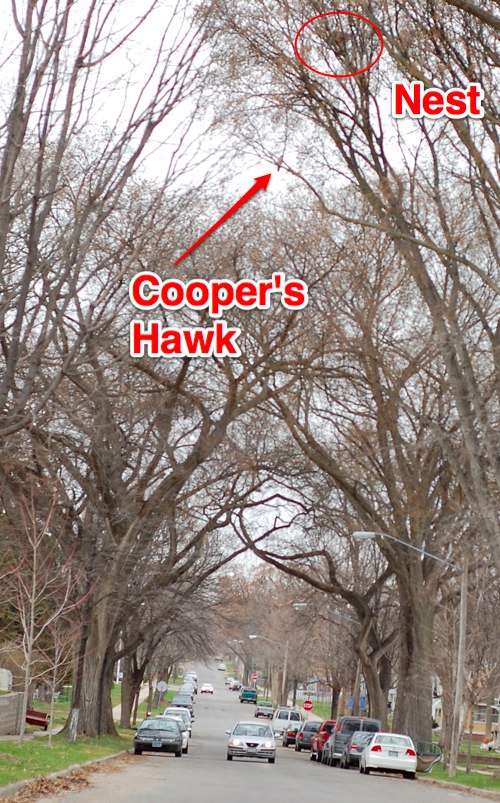
This is a very relaxed urban hawk. This Cooper's hawk has chosen to nest right over a south Minneapolis street. I always think of these hawks as fairly high strung and desiring quiet, hidden areas. Not only was this nest placed right over the road, but the hawk itself was perched in an open area.
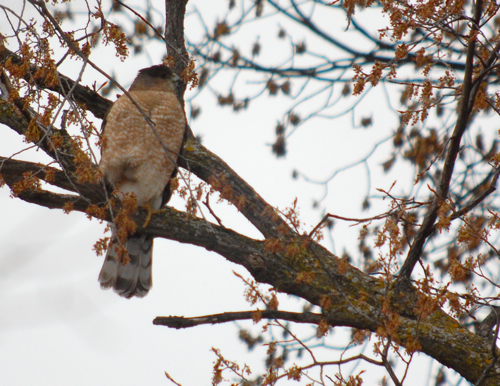
The male didn't seem to mind my scope on him for a few moments as a digiscoped a few photos. Usually, Cooper's hawks don't like that.
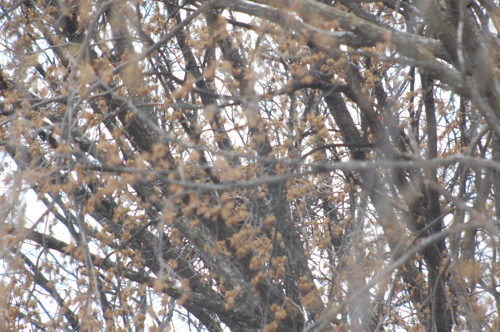
Even though the nest has been built over the street, once the buds show that once the leaves are out the nest will be well hidden. Cooper's hawks do seem to have a knack for selecting a nest spot that will be covered by leaves.
I noted all the surrounding birds singing on territory in the neighborhood, despite the male perched in the open. Robins, house finches and cardinals all sang their song. A downy woodpecker drummed his territory announcement on a nearby branch. I've often heard people express concern that Cooper's hawks nesting nearby scare away other birds. Certainly wasn't the case here.
When I worked at the bird store years ago, we had a Cooper's hawk nest nearby and even though the hawks periodically plucked off birds at the feeder (and a day old Canada goose) we had good activity all summer. I think sometimes people see what they think they should see.
I hope I have time to check this nest through the summer and I hope it does well.
Owl Chick, Finally!
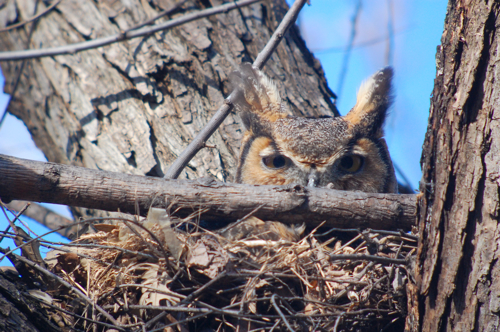 As I was working my way around my neighborhood the other day on my bike, I made one final stop before heading home to check on the great horned owl net. I hoped that since it was so warm that the female would be up and out of the nest and maybe I'd get a glimpse of a chick. She did seem to be up a little higher but I couldn't see any sign of the young. I tried scanning the trees where I usually see the male perched as a sentry over the territory, but couldn't find him. I decided to get an establishing shot of the nest.
As I was working my way around my neighborhood the other day on my bike, I made one final stop before heading home to check on the great horned owl net. I hoped that since it was so warm that the female would be up and out of the nest and maybe I'd get a glimpse of a chick. She did seem to be up a little higher but I couldn't see any sign of the young. I tried scanning the trees where I usually see the male perched as a sentry over the territory, but couldn't find him. I decided to get an establishing shot of the nest.
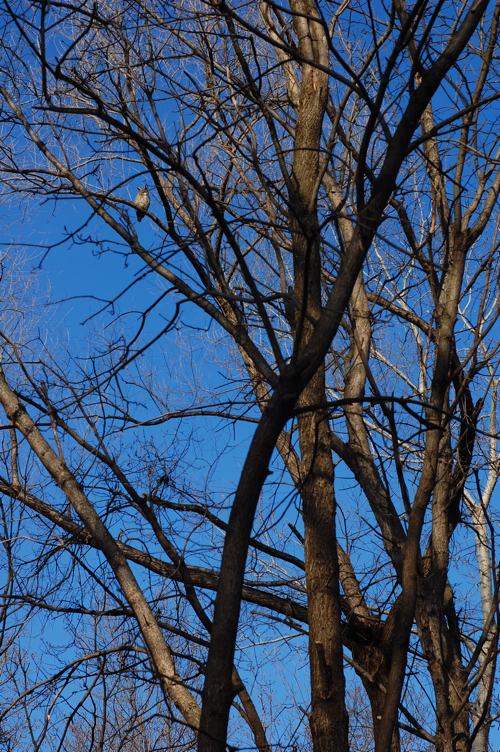
That's when I noticed him--he was perched right out in the open above the nest! Do you see where the nest is in relation to the male? The nest is in the lower right hand corner in the crotch of the tree. You can see her little tufts stick up out of the nest.
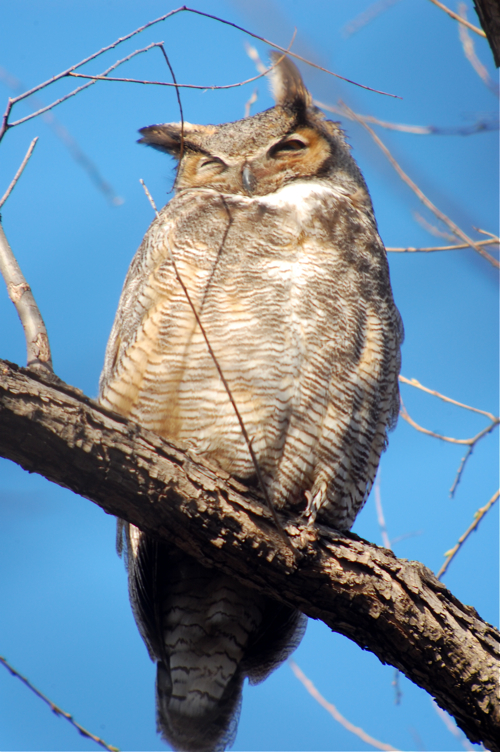
It was interesting to me that even though he was out in the open and I had my scope on him, a few people walked past me and didn't seem to notice. Yo, people, huge owl up here. As I took this photo, a Cooper's hawk flew in, circled the tree to buzz the owls and then continued on its way. It didn't vocalize but it was as if the fly by was letting the owls know, "Yeah, I see you, you're not fooling me."
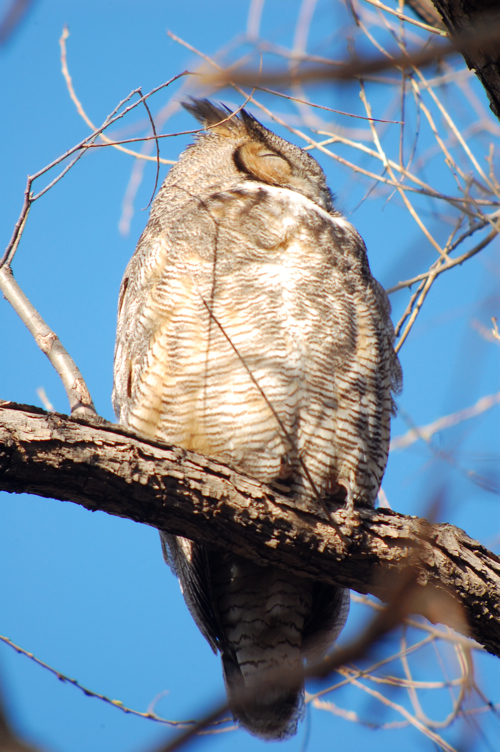
The male kept a hairy ball in the direction of the Cooper's hawk. He never looked at me again after that, but watched the fast little hawk. A few other birds came in to mob them as well.
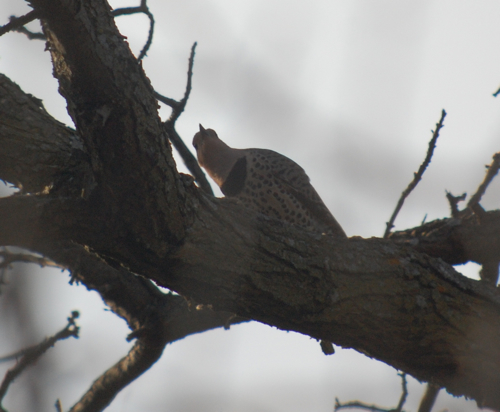
This flicker was my favorite. She slowly worked the branches for food and then suddenly noticed the owl (that photo is right when she noticed the male) and started giving a warning call. She even dove at the male a few times. I wondered if she hadn't seen the nest because all the mobbing in the world by a flicker is not going to get that owl to move. And let's face it flickers can't even drive out a starling.
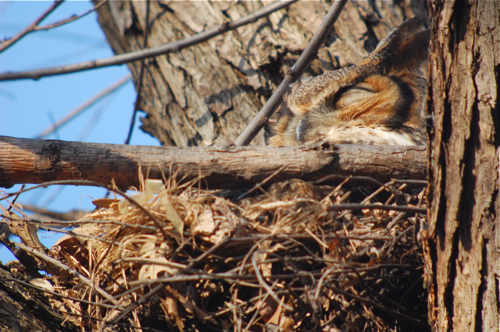
The female wasn't too worried. She seemed to be snoozing in the sun, paying no attention to me or the flicker.
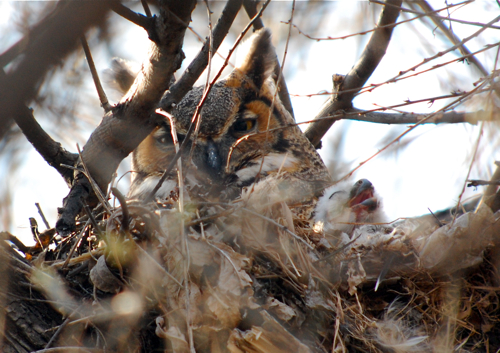
I started to leave and I turned to take one last look and then I saw the female adjust herself. I aimed the scope and up popped a baby owly head! So cute and fluffy! It shook its head a few times and then disappeared under the female again. Nice to know that there's at least one chick in the nest.
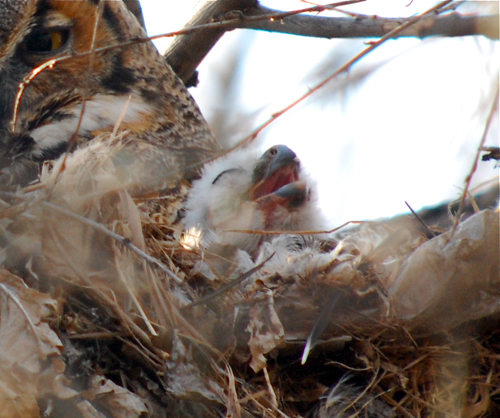
Check out the baby, see the little white dot on the tip of its bill? That's an egg tooth. Something birds have in the egg that helps them chip out of the shell. It usually sheds not long after hatching. I checked over at Cornell's Birds of North America Online and looked up owl tooth development on great horned owls: "Young show remnants of yolk sac and retain egg tooth for 4–6 days (Turner and McClanahan 1981) or traces of both egg tooth and yolk sac for up to 2 weeks (Hoffmeister and Setzer 1947). Eyes remain closed until 9-11 days of age"
Young owls don't always hatch at the same time, there can be a day or two difference. I wonder if this is the youngest owlet in the nest? It's a safe bet that these birds are less than 9 days old or hatched early last week sometime. Exciting!
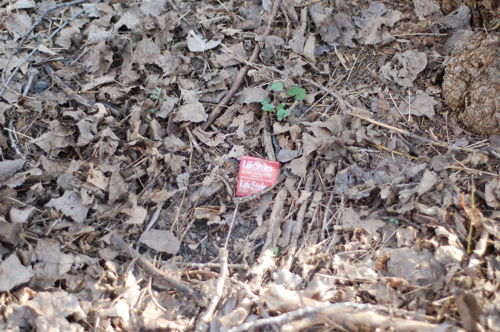
Oh and I found this empty wrapper not too far from the nest tree. I wonder what kind of shenanigans the owls witness at night?
Hazards Of Nesting In A Metal Box
As reported last week, there was trouble in the bird feeder that the house wrens had chosen to use as a nest cavity. Today, I got the conclusion of the store:
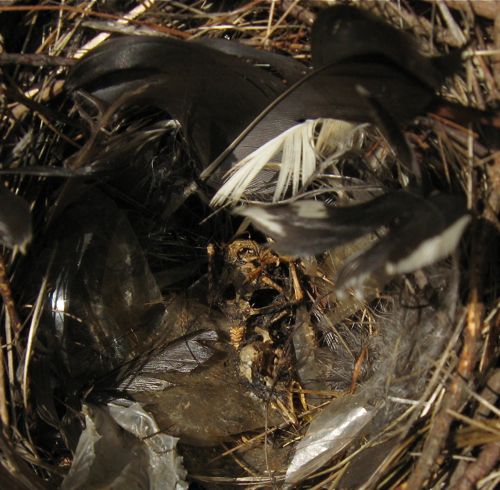
The one remaining nestling was dead. Most likely it died not long after I took it's photo the previous week. It does not look like it was the victim of a predator and chicks that young can die quickly from exposure or lack of food.

In today's ninety degree temperatures, I suspect heat had a great deal to do with the failure of this nest. This feeder gets direct sun in the afternoon and it's made of metal--not the best nursery in late July and August, even in the northern US.
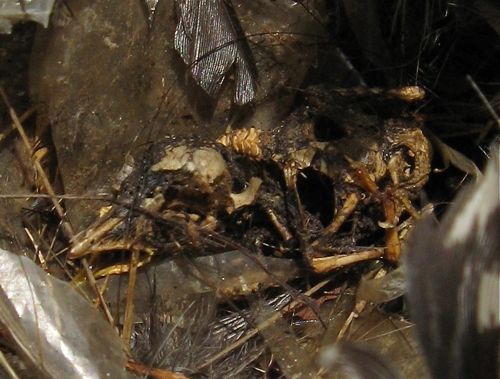
I was amazed at how quickly the chick had decomposed and marveled at the delicate beauty of the minute skeleton. I also noticed that the nest was lined with clear plastic as well as feathers. I knew house sparrows did that, but this is the first time I have seen it in a house wren nest.
It's a sad end to the bird feeder nest, but that's the way it goes sometimes for birds. They try something new and if it works, they continue to adapt to an environment continually changed by humans. If it doesn't, well they can always try twice again next year. And it's a lesson for us to make sure that this feeder stays closed all the time to prevent some other wren family from engaging in this lethal experimental nest.
Trouble In The Bird Feeder Wren Nest!
Yesterday, I was out to check on the squirrel proof Feeder with the house wren nest. On Monday, Mr. Neil sent over photos showing that three of the four eggs had hatched. I wanted to see if the final egg hatched and found something completely unexpected:
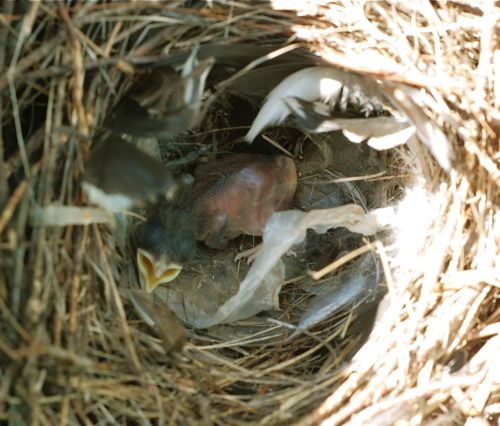
One chick and no eggs. Huh? What the heck happened? I have a couple of theories:
1. It was very hot on Tuesday--well into the 90s. This feeder is made of metal and gets late afternoon sun. Did the other chicks die from the heat and the wrens remove them?
2. A snake came up the pole and was able to eat the other chicks? But why is only one chick left? Usually snakes take everything...unless this was a really tiny snake?
I don't know. I did notice that the male didn't sing like he usually does--has he given up on the territory? I did see a wren leave the feeder a few times, so I know at least one of the pair is still feeding this chick. I'll be interested to see if this bird actually leaves the nest.
It's a demonstration of how wrens and many other bird species play the odds when raising chicks. They'll go for an extra brood, they'll try out a new next spot, they lay four to five eggs--if it works, great! If it doesn't, they'll know better next time.
Feeder Wrens Hatched!
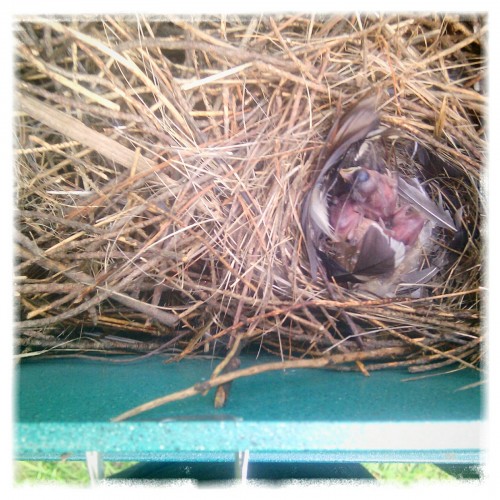 Last night on Twitter, Mr. Neil posted a photo alerting me that the house wrens in the squirrel proof feeder hatched. Look at those little naked chicks, they look fresh from the shell!
Last night on Twitter, Mr. Neil posted a photo alerting me that the house wrens in the squirrel proof feeder hatched. Look at those little naked chicks, they look fresh from the shell!
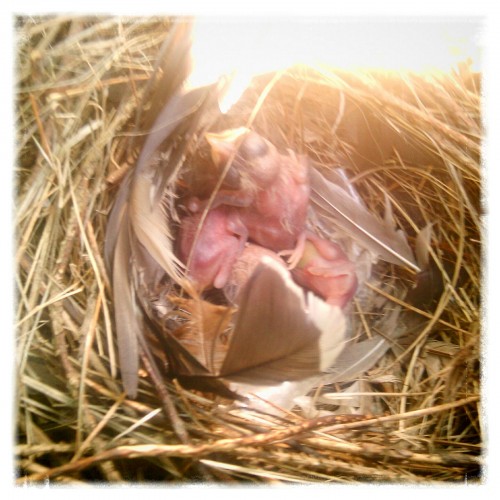 Look at the wee little toes! It looks like three of them have hatched and last I checked, there were four eggs. I'll be out on Wednesday to indulge in my fried green tomato habit (my all time favorite food outside of roasted eggplant with parmesan cheese...and well, bacon--but really, bacon should always go without saying). Anyway, I'll be out tomorrow to check on the hatchlings.
Look at the wee little toes! It looks like three of them have hatched and last I checked, there were four eggs. I'll be out on Wednesday to indulge in my fried green tomato habit (my all time favorite food outside of roasted eggplant with parmesan cheese...and well, bacon--but really, bacon should always go without saying). Anyway, I'll be out tomorrow to check on the hatchlings.
I looked at my original blog post on July 13 when I predicted that incubation would start on the 14th and twelve days of incubation. And what do you know? Yesterday, July 26 would have been 12 days of incubation! That means in two weeks or around August 8, the wrens will probably fledge. Then they have lots to learn on how to feed themselves and then the will commence to migratin'. They have a lot of work to do in a very little amount of time.
The Hazards Of An Empty Feeder
When I can't fill the feeders at Mr. Neil's house, the groundskeeper named Hans usually does the honors. He does an admirable job but he has a ton of things to do like maintaining trails and keeping the grass and weeds trimmed around the beehives. And now that we have 8 beehives, let's bow our heads in honor of dear, sweet Hans who has sustained more stings than any of us and yet makes life easier for hive inspections. Moment.
But sometimes certain feeders go empty (especially the suet log, because I appear to be the only person in the US who actually enjoys the feeling of squashed animal fat mixed with peanut butter on my fingers). And this summer, the safflower feeder went empty but Mr. Neil called me over to see what had been filled inside in place of the usual safflower:
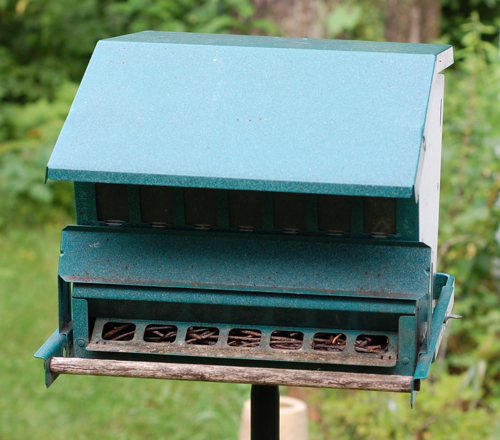
I knew as soon as I saw the feeding ports what had moved in, but then wondered, "How did a house wren fit in there? I know they are tiny, but wow!" House wrens are the smallest cavity nesting birds in our neck of the woods. They only need a hole that is one inch in diameter to fit their tiny bodies through. The other thing is that you can usually id the type of cavity nesting bird in your nest box by the material--house wrens are all sticks. Chickadees usually weave a neat fur lined cup nest, bluebirds nests are made of fine grasses and tree swallows line the nest cup with huge feathers from ducks. House sparrows will make a nest out of everything: grass, sticks, vines, cellophane, cigarette butts, etc.
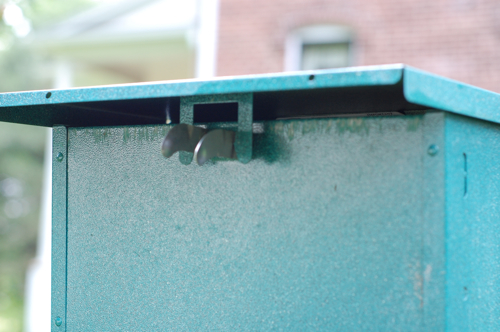
As I wondered how the house wren was getting in out of the feeder, I soon had my answer. Apparently the lid had been left only slightly ajar and that was all the enterprising little male needed to collect twigs.
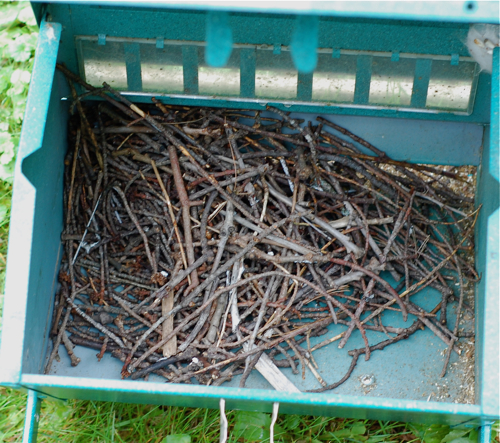
When we looked inside, we could see a whole pile of sticks, but no complete nest. One of the really interesting things about the tiny house wren is that they will make five nests, use one to rear chicks and the rest as decoys to fool marauding predators (even defending a decoy nest as if there were eggs inside--clever birds). I figured this was going to be a decoy nest. Mr. Neil didn't mind the wrens so we left the roof ajar.
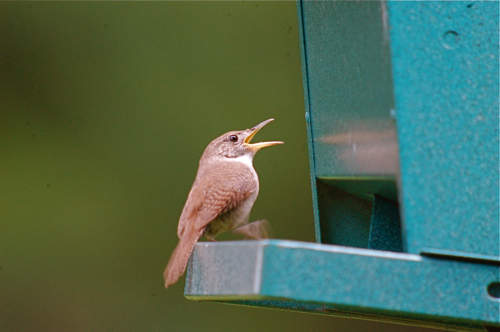
Non Birding Bill and I came over for a bee inspection and some grilling and we watched the wren declare his territory in boisterous song.
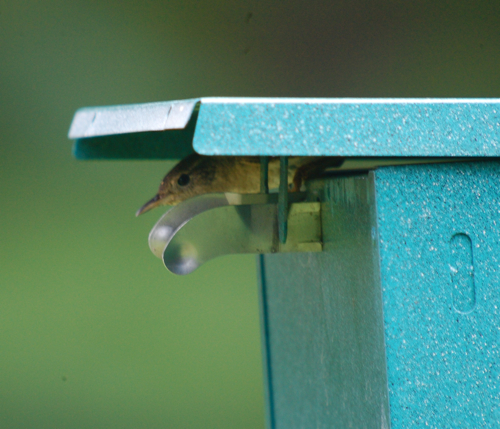
There was at least one female who took him up on his twittery offer and inspected the feeder inside and out. I always figured that the males put sticks in several locations, the female chooses the one she will use for eggs and the rest become the decoys. She flew off after a few moments and I thought, "She's going to make that one the decoy."
Cut to one week later! On Sunday, we arrived for another cookout at Mr. Neil's and as soon as we arrived he took me out to the feeder and showed me this:
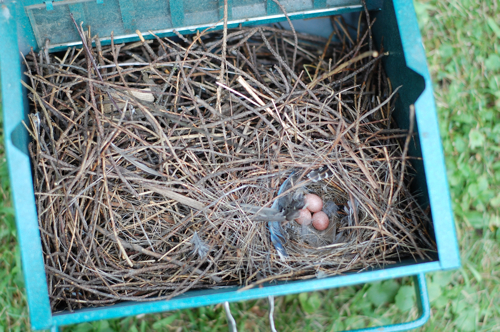
Gah! A feeder full of sticks, a small feather-lined cup and three tiny house wren eggs. Well, this feeder is out of commission for a month. I think the female was still in process of laying eggs and that incubation will start today or tomorrow. From there we have about 12 days of incubation and then another 12 - 13 days before the chicks fledge. I think the other birds can live without safflower that long.
I must say that this breaks one of my bird feeding rules of thumb: don't have nest boxes around your bird feeding station. Birds generally don't want to nest near where nest raiders show up on a regular basis (ie squirrels, chipmunks, blue jays, crows, woodpeckers, raccoons, etc). At least they nested in a squirrel proof feeder, so that solves that problem and maybe the wren's nest decoy strategy will fool the other egg eaters?
Red-breasted Nuthatch Nest Construction
I headed out yesterday with Lorraine to do some serious wildflower walking (what the heck has happened to me, I'm interested in wildflowers now) near our beeyard. Before Lorraine arrived, I headed down in the woods to see if I could figure out what birds were setting up territory where--I like to get know the neighborhood on the trail to our beehives. There's a pair of Cooper's hawks that have been "kekking" around the hives, but I cannot find the nest at all. There's a creek on the property line, so it's possible that it's across the creek, but from the calling interactions, it sounds like the nest is on Mr. Neil's property. Where ever the nest is, I'm glad they feel welcome (and may they eat lots of deer mice).
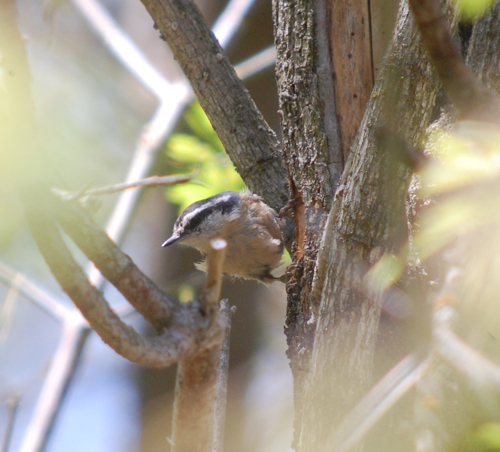
But, while enjoying birds and vainly pursuing Cooper's hawks, I heard some serious pecking going on--it was loud. I wondered if it was a downy woodpecker excavating a cavity and was shocked to discover that it was a female red-breasted nuthatch. That tiny little thing was making some seriously loud pecking sounds! She was actually across the creek and I was still able to hear her. You'll note a little haziness in these images, with the leaves coming out this nest is going to be well hidden very soon. I marked where I stood, but who knows if in a week if it will be visible. I was excited to find my first ever red-breasted nuthatch nest though.
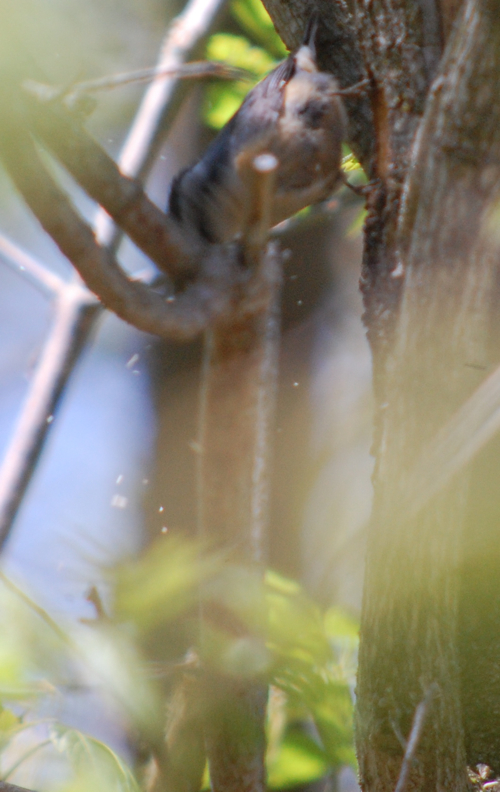
Pitooey! Look at that spray of debris! She was really going to town. It was interesting to note that she was not wearing a band, Mark and Roger have not banded her yet and they have banded a few red-breasteds when they come out to Mr. Neil's. I found it interesting that the female was excavating the cavity, that seems like something a male would do. I checked the handy dandy Birds of North America Online and it reads that female red-breasted nuthatches select the nesting site. It did mention that males who had not paired up early on may excavate four different sites to show a prospective female. The above female worked and then disappeared. I heard some chattering and soon, a male flew in and took over excavation duties:
[youtube]http://www.youtube.com/watch?v=Y-NJGGvH-Ks&feature=channel[/youtube]
He was much more vocal as he excavated where the female had been silent. It reminded me of one of those arguments you can have in a marriage where the male may be doing one thing (like excavating four different holes for you to lay eggs in) and quietly, the female begins work on the place she really wants. The male then comes over to excavate and mutters, "Dammit, I excavated 4 different holes and then she picks one way at the far edge of the territory and now I have to start over on a new one! What does she think my bill is made of? A woodpecker bill? Ratcha Fracka Friker Frack!"
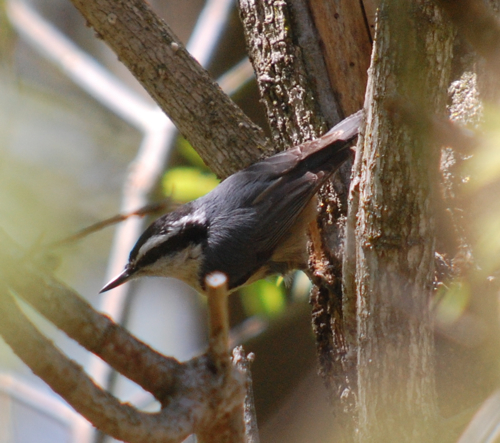
They are excavating near where I hear all of the Cooper's hawk kekking. I hope I'm able to keep watching this nest through the leaves and that the two unlikely neighbors get along.
